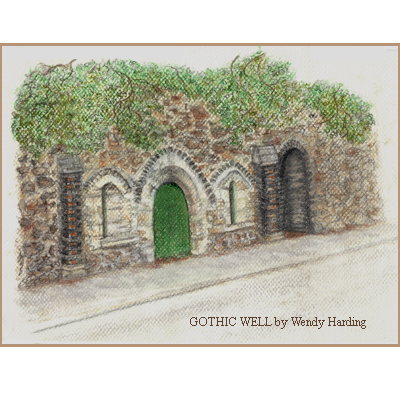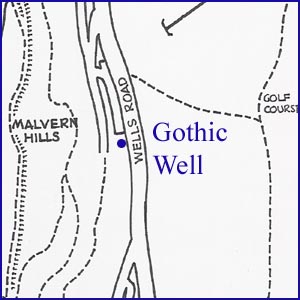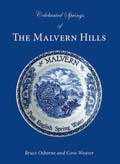
| 
|


Gothic Well Grotto
NGR 77238 43192
Site Number: C76
By Bruce Osborne and Cora Weaver (C) 2012
Area 5. Malvern Wells Area Springs and Wells
Malvern Hills, England
Description: a subterranean public well house for local residents with roadside access now walled up.
This interesting site justifies total restoration. It comprises an underground chamber at the back of which is a well. It is believed to have been constructed as a Victorian ornamental grotto landscape feature. The Gothic Well provided a domestic water supply and one can imagine servants collecting water from the underground chamber and carrying it back to the sculleries and kitchens using the nearby archway and steps.
The style of the former entrance on the main road was neo-gothic and was part of a much larger Victorian development, which included the substantial houses above and to the right in Hanley Terrace. For the occupants of the house directly above the well there was a shaft down from the garden above, which avoided the necessity of using the pavement entrance. This house was formerly known as The Pleasance and the spring is mentioned in the 1919 sale catalogue of the Hornyold Estate.

 grotto. Malvern has lost a unique water feature that could have been transformed into a mystical underground chamber attracting local visitors and interest in the property. The owner David Prentice passed away in 2014, shortly after the destruction of the Gothic Well in 2013.
grotto. Malvern has lost a unique water feature that could have been transformed into a mystical underground chamber attracting local visitors and interest in the property. The owner David Prentice passed away in 2014, shortly after the destruction of the Gothic Well in 2013.
2. After brickwork replaced the doors.
Website: Click Here
SUPPLEMENTARY INFORMATION

Celebrated Springs of
THE MALVERN HILLS
 A definitive work that is the culmination of 20 years researching the springs and wells of the Malvern Hills, published by Phillimore. This is the ideal explorers guide enabling the reader to discover the location and often the astounding and long forgotten history of over 130 celebrated springs and wells sites around the Malvern Hills. The book is hard back with dust cover, large quarto size with lavish illustrations and extended text. Celebrated Springs contains about 200 illustrations and well researched text over a similar number of pages, together with seven area maps to guide the explorer to the locations around the Malvern Hills. It also includes details on the long history of bottling water in the Malvern Hills.
A definitive work that is the culmination of 20 years researching the springs and wells of the Malvern Hills, published by Phillimore. This is the ideal explorers guide enabling the reader to discover the location and often the astounding and long forgotten history of over 130 celebrated springs and wells sites around the Malvern Hills. The book is hard back with dust cover, large quarto size with lavish illustrations and extended text. Celebrated Springs contains about 200 illustrations and well researched text over a similar number of pages, together with seven area maps to guide the explorer to the locations around the Malvern Hills. It also includes details on the long history of bottling water in the Malvern Hills.
Written by Bruce Osborne and Cora Weaver, this book is available on-line for £15.00 (delivered UK) - click Malvern Bookshop on the green panel top left. Alternatively send a cheque payable to Cora Weaver with your name and address to 4 Hall Green, Malvern, Worcs. WR14 3QX.
1) TOPOGRAPHICAL LOCATION:
Malvern Hills - arguably Britain's original National Park
2) LANDSCAPE:
Built Up Location3) INFORMATION CATEGORY:
A Spring, Spout, Fountain or Holy Well SiteGrotto
4) MALVERN SPRING OR WELL SITE DETAILS:
Site with Malvern Water1 SPLASH - Lost - Nothing Much To See

5) GENERAL VISITOR INFORMATION:
Access By RoadNot Open To Public
Free Parking Nearby



